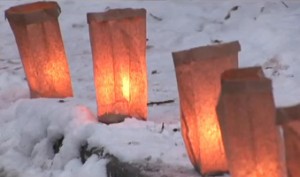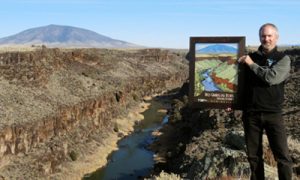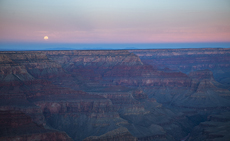In 2017, SOMOS, the literary society of Taos since 1983, realized a long-time dream of creating the position of Poet Laureate in Taos. In August, the Taos Town Council approved the idea. A call for entries commenced, then a jurying* process ensued. By the end of the year, Sawnie Morris was announced as the inaugural Taos Poet Laureate. Her two-year reign began when she was introduced to the Taos mayor and city council members on January 23, 2018.

On February 15, 2018 Sawnie Morris spoke to an enthusiastic audience of SOMOS friends. Here is a transcript of her first public presentation as Taos Poet Laureate.
Comments from Taos Poet Laureate
 My gratitude goes to Jan Smith, members of the Board of Directors of SOMOS, the Town of Taos, the Witter Bynner Foundation, the judges, and to all of you who took the time to be here today to celebrate poetry with me.
My gratitude goes to Jan Smith, members of the Board of Directors of SOMOS, the Town of Taos, the Witter Bynner Foundation, the judges, and to all of you who took the time to be here today to celebrate poetry with me.
I am honored to assume the role and responsibilities of the Inaugural Poet Laureate of Taos.
The first thing I want to say is that this is not about me – this is about us!
The poet laureateship is about living in a community that values the literary arts enough to recognize them in this way. It is about all of us who are mad enough and blessed enough to consecrate our lives to writing – and to do so in a small rural town in the mountains.
No matter what genre we write in, poetry is at the core of it. Every word is a poem. Every word began as a metaphor, an image, a sound meant to evoke something or someone, meant to communicate with others. As past U.S. Poet Laureate Billy Collins has said, poetry is the way the human heart tells its story.
We need that.
I am keenly aware that we are all in various stages of becoming and in this room, in this community, exist many, working more or less anonymously, everyday, who – because of their commitment and courage – are contributing to the light of consciousness that is poetry – and whose work, because of their dedication, will be recognized. I applaud and want to encourage that.
I am also aware that many people are afraid of poetry, until or unless they have an encounter when their guard isn’t up. With that in mind, my project as the Inaugural Poet Laureate is called POETRY IN WAITING and was inspired by the Poetry Society of America’s Poetry in Motion project, and an intimate encounter I had with a fragment from a Wallace Stevens poem that was on the wall of a subway in Manhatten in the early 90s. Taos does not have an extensive public transportation service, but we do have waiting rooms. For my project, I aim to post a poem or poem-fragment everywhere that people have a moment – by choice or necessity – to wait – which is to say, to pause, sit, reflect. For example, a bilingual poem by Neruda in the ER, a poem by Joy Harjo or Sherman Alexie at the movie theaters, a Juan Felipe Herrera poem on the Chili Line, a Mary Ruefle or Gwendolyn Brooks poem on the walls of doctors’ offices, insurance offices, auto repair shops, the jail, the DMV. (And, as more than one person has joked, maybe we need two poems in the DMV.)
Finally, I wish to make acknowledgement of just a few of the institutions, structures, and people working on behalf of poetry in our community. This list is, of course, not exhaustive.
- We have SOMOS: Phyllis Hotch, Dori Vinella, Jan Smith, and all of the members of the board of directors now and over the years.
- We have SOMOS’s annual Poetry Series, which is part of National Poetry Month, and which Veronica Golos has curated for a number of years now and Arianna Kramer will be curating for 2018.
- We have James Navé’s Taos Poetry Festival
- We have the Taos Journal of International Poetry and Art, editors Veronica Golos and Cathy Strisk
- And its forerunner, the Taos Review, that was primarily edited by the late ‘Annah Sobleman, along with Bill Gersh, Steve Rose, Renee Gregorio, and myself.
- We have KCEI’s recordings and interviews of poets, thanks to Mike Tilley, Robin Collier, and Nancy Ryan.
- We have Poets Outloud at the high school, with Francis Hahn and Annie MacNaughton.
- We have the Wurlitzer Foundation, which has brought so many writers to Taos, many of whom have stayed and/or discretely returned for extended writing retreats.
- We have Andrea Watson’s 3: A Taos Press.
- And in the past we had the Taos Poetry Circus, thanks to Annie MacNaughton.
We also have a number of poets with national reputations who are teaching poetry independently and/or through SOMOS: Lise Geott’s fire side chats and seminars; workshops with Veronica Golos, Cathy Strisik, and Leslie Ullman, and also the late Elaine Sutton; as well as, Robin Shawver and Kate O’Neil at UNM; and in the schools, Ned Doughtery and – one way or another – I’m sure, John Biscello; and for many years Sue Goldberg. I also want give a nod to the therapists working behind the scenes, who bring poetry in their practices; and all of teachers who are providing their students and clients with the special form of attention to the world that poetry provides.
I am also thinking of the liturgies that are spoken throughout our town on a weekly basis. And I want to express my personal gratitude for the Pueblo and the ceremonial dances that take place there and that are, in my experience, an ongoing and profoundly rooted manifestation of Poetry that through a kind of osmosis, if nothing else, have had a deep influence on my life and my work.
All of this reflects the values of our community – and in many cases the people who visit our community. Thank you.

The Literary Legacy of Taos
Taos has a strong literary history. I have assembled a few poems and poem-fragments – written by poets who have made Taos their home or spent a great deal of time in Taos – that I want to share with you.
D.H. LAWRENCE lived and wrote in Taos in the 1920s.
Go deeper than love, for the soul has greater depth,
love is like the grass, but the heart is deep wild rock
molten, yet dense and permanent.
Go down to your deep old heart, and lose sight of yourself.
And lose sight of me, the me whom you turbulently loved.
Let us lose sight of ourselves, and break the mirrors.
For the fierce curve of our lives is moving again to the depth
out of sight, in the deep living.
ROBERT CREELEY lived and wrote in Taos in the 1950s.
America, you ode of reality!
Give back the people you took.
Let the sun shine again
On the four corners of the world
You thought of first but do not
Own, or keep like a convenience.
People are your own word, you
Invented the locus and term
Here, you said and say, is
Where we are. Give back
What we are , these people you made,
Us, and nowhere but you to be.
TONY MARES died just a few years ago. Though he was from Albuquerque, this fragment is from his book-length poem Astonishing Light, which presents in poetic form a series of conversations with Taos sculptor, Patriciño Barela.
Mira, hermano, there are good priests.
But I try to avoid them all, the good and the bad.
I carve my figures from what I see here,
inside myself. A tender world,
mellow and rich como una dulce guitarra,
is what I see in the wood. Old people,
children, parents and friends
are alive in the grain of the wood
I want to play like a sweet guitar.
Their voices come to me softened
by the morning fog. The drift
and spiral from the twists and turns
of splintered lives. These voices
have the fresh scent of cedar in the forest.
I try to set them free. That is all.
LUCY TAPAHONSO is Diné and the Inaugural Poet Laureate of the Navajo Nation. She is a frequent visitor to Taos and her work was important to me in my very early days in Taos. This fragment is from a poem in her collection Sáanii Dahataal, The Women Are Singing.
BLUE HORSES RUSH IN
Before the birth, she moved and pushed inside her mother.
Her heart pounded quickly and we recognized the sound of horses running:
The thundering of hooves on the desert floor.
Her mother clenched her fists and gasped.
She moans ageless pain and pushes: This is it!
Chamisa slips out, glistening wet and takes her first breath.
The wind outside swirls small leaves
and branches in the dark.
JOY HARJO spent decades living in Albuquerque and has also spent time in Taos. Her poems had a tremendous influence on my own in my early years of writing. This is an excerpt from her poem “Grace” that appears in In Mad Love and War.
I could say Grace was a woman with time on her hands, or a white buffalo escaped from memory. But in that dingy light it was a promise of balance. We once again understood the talk of animals, and spring was lean and hungry with the hope of children and corn.
‘ANNAH SOBELMAN, who lived in Taos off and on for a total of close to 20 years and died last summer. This is her poem “A Physics of Desire,” from her collection, In the Bee Latitudes.
JEAN VALENTINE has been a repeat resident at the Wurlitzer Foundation and returns to Taos from time to time to write. This is the title poem from her collection, Door in the Mountain.
Never ran this hard through the valley
never ate so many stars
I was carrying a dead deer
tied on to my neck and shoulders
deer legs hanging in front of me
heavy on my chest
People are not wanting
to let me in
Door in the mountain
let me in.
I want to share this additional poem of Jean Valentine’s because it is so relevant to our time, published in the New York Times Magazine.
In blue-green air & water God
you have come back for us,
to our fiberglass boat.
You have come back for us, & I’m afraid.
(But you never left.)
Great sadness at harms.
But nothing that comes now, after,
can be like before.
Even when the icebergs are gone, and the millions of suns
have burnt themselves out of your arms,
your arms of burnt air,
you are with us
whoever we are then.
Taos has an illustrious and inspiring history of poets and poetry!
Clothespins on the Line by Sawnie Morris
I’ll end with a poem of my own that appeared last April in Poetry, titled “Clothespins on the Line.”
look like birds. Scrawny
winter birds balanced by two sarong
tail feathers. Some look west,
others north-
east toward the
mountain. Stiff in the cold &
remote. They haven’t been loved
enough. They grow
thinner and thinner in their woody
streaked feathers, held together only by
the exposed spiral of internal
organs. After a while , the sun comes
out and all o f the birds, clutching wire, turn
an electric silver.
This is hopeful,, but doesn’t last. Clouds
take a break from one another , ,
re-
convene. A half-inch of
snow is rolled out with perfect evenness
across the picnic table, as though
someone made a blank
for what was
coming. The nice thing
about clothespin birds is they don’t
“excrete.”
Jays & grosbeaks & finches
& mourning doves + ravens leave
their paintings
everywhere , on benches & limbs ,, , on fallen
pine needle fascicles \|/ feldspar & quartz _ __
though all has now become
gesso beneath snow. After a certain amount of
feeling
hopelessly under-
accomplished, you look at your nails
and want to
paint them. Is this how birds
feel? No. Birds fly
and don’t look
down. Or, they sit `’’ amid branches
and peck at the brittle waffled bark
& tiny bugs buried
in the marrow. .< sszt sszt sszt .< You, too,
peck. Familiar letters on t he keys have lost
their definition and resemble finger-
tip-size daubs of bird paint on back-
lit platforms. You recall the s e & m
only via entrenched neural pathways ,
while the l and c continue to
morph into tiny archaic
symbols. As though, the unconscious
is forming a message. ( Always “it” has something
unearthly to say. ) Except
the unconscious is
the earth , it’s just we
don’t know how she does it.
St. Thomas of Aquinas got a delirium
hit of t hat at the end
and decided to marry it. Each day
your thumbs grow paler, nails coarser, evolving
toward the ptero-
dactyl: part reptile, part bird.
As a child
pterodactyls scared you, which meant
they had your attention. Refusing to stay
in the lineage, they became
their own form.
They had an iguana for a father
and a pelican for a mom,
crispy and dipped in molasses.
If you were big enough
you could eat them
the way some people eat grass-
hoppers. Compulsive hole-
punchers, if less manic
could be sculptors,
though it requires d-e-t-a-c-h-m-e-n-t
to see it that way , , if you are
a lilac leaf sketching outside
the library window. What are those books
doing in there together ?! Nothing !
When a new one arrives, they fall in
love,, one by one. Inside their covers,
a million leaves, each
w/ black growth. A pattern of fungus ,
the shed skin of snakes & dna
traces. Like bird poop,
but more orderly and the message is see-
through. Don’t you
wish you could lift the letters
and release them halfway
back to
the liquid state ,, , before they got connected to
the circuitry? It might be kind of
relaxing. You might be
as good of a
painter
as a cuckoo bird. A few nights ago
you dreamt you were very pregnant &
in need of a place to give birth. Your boyfriend
had left you and 2 therapists
let you live w/ them
because you resembled their daughter —
though they were suspicious. Who can blame them?
As for your nails,
find a mani-
curist, someone who knows what they are
doing. Druids never lived here,
that was Europe, but you
and the sage-
brush
are distantly related via microbial
ancestors; in spite of yourself, you are
surrounded
by family. \\|/
Thank you for being here and for your support of poetry.
About Sawnie Morris
 Sawnie is a poet and a prose writer. She teaches poetry, prose, and dreamwork privately, online, at universities, and for small groups at her Ranchos de Taos home studio. Sawnie is an environmental activist and served as director of Amigos Bravos: Because Water Matters for many years. She is married to Taos artist, Brian Shields.
Sawnie is a poet and a prose writer. She teaches poetry, prose, and dreamwork privately, online, at universities, and for small groups at her Ranchos de Taos home studio. Sawnie is an environmental activist and served as director of Amigos Bravos: Because Water Matters for many years. She is married to Taos artist, Brian Shields.
Learn more:
SOMOS, Literary Society of Taos
About Poet Laureates (by Wikipedia)
* The four poet laureate judges were Ceramic Sculptor artist, Deborah Rael-Buckley; Middle School teacher and Town Councilman, Nathaniel Evans; Director of the UNM Library, Kathleen Knoth; and musician/artist/writer, Joshua Concha.




